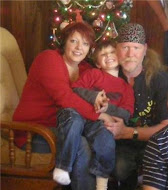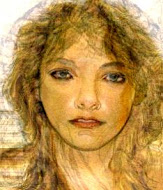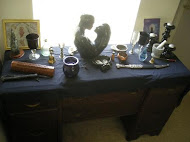- * Celebrating Halloween * by Waverly Fitzgerald © 1998
I love Halloween. It's one of my favorite holidays. When my daughter was young enough to go trick-or-treating, I loved wandering down dark streets in the crisp air, with the leaves crunching under my feet, passing strange apparitions, always with a hint of fear, the sense that something is lurking in the darkness. I remember the edge of wildness I felt in the air when I went trick-or-treating as a child. I like putting on a costume, displaying some aspect of myself (usually glamorous) that I normally hide. But over the past few years, my attention has shifted away from trick-or-treating and parties towards the main theme of this dark festival: death. Halloween is one of the great quarter-days or pagan festivals which fall midway between the solstices and the equinoxes. That makes it an agricultural festival--it marks the time of the last harvest, the winter slaughter, the death of the crops and the rest cycle of the land.
The Saxons called it Winter's Eve. The Celts called it Samhain, after their Lord of Death; it was also their new year. To the Celts, the day began with night fall. Thus it was natural for the year to begin at the start of the darkest time of the year. Celtic feasts were celebrated from sunset to sunset, so Samhain began at sunset on October 31st and continued until sunset November 1st. As with other great pagan holidays, the Catholic Church found a way to claim it. The Feast of All Saints, which came into existence in the 7th century, was commemorated on November 1 under the name of All Hallows Day, from which we get the name Halloween (the eve of Hallows). The following day, November 2, is All Souls Day, a day when the priest wears black, the church is draped with mourning and the faithful pray for the souls of their departed, with the hope of shortening their time in Purgatory.
The Month of Blood
There are some obvious reasons why this place on the Wheel of the Year is associated with death. The sun is approaching its nadir, the leaves are falling from trees, the death and decay in the natural world remind us of our own mortality. Martinmas, November 11th, was the traditional time for slaughtering the cattle, sheep and pigs which could not be maintained during the winter. The Welsh called November the month of Slaughter while the Saxons called it the Month of Blood. In the Odyssey, Odysseus summons the shades of the dead by sacrificing animals. Their blood drains into a pit and the restless shades come eagerly crowing up from the underworld. Odysseus holds them at bay with his sword until the particular spirit he wants comes forward, laps up the blood and then prophesies what will happen in the future. This scene combines the themes of fear, slaughter, death, the Underworld, ghosts and divination which are common to Halloween.
The Days of the Dead
In Mexico, All Souls Day is called Dia de Muertos (Day of the Dead) and is a time of commemorating the dead by decorating their tombs (with marigolds, a flower sacred to the Aztecs) and inviting them to a feast in their honor. Families go to the cemetery for a picnic and eat skeleton cookies and sugar skull cakes. Trick-or-treating derives from an ancient British custom of going from house to house begging for soul-cakes (see recipe). Some say the soul-cakes were given to the priest to buy Masses for the souls of relatives in Purgatory. Others believe they were offerings to the dead. Candles flickering in the windows (or pumpkins) were meant to
serve as beacons for the dead, just as on the similar holiday in Japan, lanterns are hung by the garden gates.
The custom of dressing in costume and 'trick-or-treating' is of Celtic origin with survivals particularly strong in Scotland. However, there are some important differences from the modern version. In the first place, the custom was not relegated to children, but was actively indulged in by adults as well. Also, the 'treat' which was required was often one of spirits (the liquid variety). This has recently been revived by college students who go 'trick-or-drinking'. And in ancient times, the roving bands would sing seasonal carols from house to house, making the tradition very similar to Yuletide wassailing. In fact, the custom known as 'caroling', now connected exclusively with mid-winter, was once practiced at all the major holidays. Finally, in Scotland at least, the tradition of dressing in costume consisted almost exclusively of cross-dressing (i.e., men dressing as women, and women as men). It seems as though ancient societies provided an opportunity for people to 'try on' the role of the opposite gender for one night of the year. (Although in Scotland, this is admittedly less dramatic - but more confusing - since men were in the habit of wearing skirt-like kilts anyway. Oh well...) From the document All Hallow's Eve Copyright © 1986, 1999 by Mike Nichols) This document can be re-published only as long as no information is lost or changed, credit is given to the author, and it is provided or used without cost to others.)
Celebrating
Decorating for this holy day is easy since there are so many items available for Halloween which will set the proper tone of mortality: autumn leaves, skeletons, miniature coffins, skulls, tombstones, pumpkins carved with terrifying faces, black candles. Every year I make a pilgrimage to the Folk Art Gallery-La Tienda at 4138 University Way NE in Seattle, which carries a selection of calaveras, macabre little skeleton figures doing wonderfully unlikely things like getting married and playing in a rock and roll band. We buy one each year to add to our Dia de Muertos altar. Pumpkins, apples and nuts are harvested at this time of the year and are associated with various Halloween customs. After the apple harvest, it's time to make wassail, a drink of hard apple cider (or soft apple juice), heated with spices and with whole apples floating on top. When the apples are heated enough they burst and make a froth on the top of the wassail. While you enjoy the fruits of the harvest, you can honor their source by wassailing the trees. Go out to the trees which have shared their bounty with you and thank them, drink a toast and pour a libation on their roots. For a dramatic but simple Halloween ritual I recommend this piece of the long and beautiful Samhain ritual described by Starhawk in The Spiral Dance.
Light candles in a dark room. Take a pomegranate and hold it up saying,"Behold, the fruit of life -"
Put it down on a plate and cut it open with a knife, saying
"- which is death."
The ruby-red juice of the pomegranate will look like blood in the candlelight. Then hold up an especially shiny red apple - one that reminds you of the apple the stepmother gave Snow White - and say
"Behold the fruit of death -"
Put it down and slice it open horizontally rather than vertically. Hold it up so others can see the five-pointed star made by the seeds and say
"- which is life."
Cut up the rest of the apple and feed it to each other or use it for one of the forms of divination described below.Honoring the Dead There are many ways you can honor the dead, starting with the simple act of setting out food for them. While you're at home and can properly supervise, place lighted candles in the windows to serve as beacons for the spirits. Host a Feast of the Dead. Set a place at the table for the dead and offer them servings of the food you eat. Invite departed friend and relatives, ancestors and heroines. Ask the living participants to share a memory about someone who has died who was important to them. Light a candle or ring a bell for each person after you speak about them. In Feeding the Spirit, Nancy Brady Cunningham suggests a variation of a Shinto tradition: cut out or draw pictures of things the dead would like. Then burn them in the fire (or candle flame), saying something like, "George, I am sending you new clothes for your journey in the spirit world." You can also make an altar for your ancestors. Our family has a Dia de Muertos altar which my daughter began in elementary school. Each year we set it up, decorate it with marigolds and add new objects: a milk bone for a dead dog, sunflower seeds for a dead hamster, pizza for a dead grandfather. Z Budapest in Grandmother of Time suggests putting pictures of your departed relatives in the middle of the altar, burning white and yellow devotional candles and incense, and talking to them. If you feel uncomfortable talking out loud, write letters. You can burn these too and imagine the smoke carrying your message. Divining the Future After being fed and entertained, the ghosts might provide oracular advice as they did for Odysseus. Since the spirits are so close to us on this night, this is an excellent time for all forms of divination. You have more access to your personal underworld, your unconscious. Consult your favorite oracle - the tarot cards, the I Ching, a Ouija board, runes, tea leaves or a crystal ball. Request images of what you can become or what you will do in the new year. There are many traditional forms of divination practiced on this night, most of them used to reveal the identity of your future spouse. If this is not something you need to know, ask for another vision. Several forms of divination involve apples. For instance, you are advised to take a candle, go alone to a mirror in a darkened room and eat the apple while looking into the mirror, combing your hair all the while. The face of your lover - or the Devil - will appear over your shoulder. A variation of this says you only have to peel the apple while looking into the mirror. ***Side note here - I have serious issues with mirrors and dark rooms in combination, and I would never suggest someone do something that involves the two. However, in an attempt to keep the information I provide as close to original, I am including this information.**** Or you can cut an apple into nine equal parts (this seems the hardest part of this method to me), eat eight of them, toss the ninth over your left shoulder, turn quickly and glimpse your future mate. I prefer the simpler method of peeling an apple so that the skin comes off in one continuous strip, throwing this over your left shoulder and looking to see the initial it forms. Since Gypsy girls and Celtic queens chose their consorts by tossing them an apple, you could take the ball into your own hands, so to speak, by tossing your chosen one an apple. Couples who want information about their relationship are advised to place a pair of nuts (or apple pips) in the fire and watch them. Unfortunately the advice on how to interpret them varies. Some say if the nuts pop at the same time, the couple will marry. Others say this means they will spring apart. As with all oracles, your interpretation is the most important part. If you are choosing from among several possibilities, name the nuts and then watch to see which one bursts first. In Montgomeryshire in Wales, the mash of nine sort is served on Halloween. This mash contains potatoes, carrots, turnips, peas, parsnips, leeks, pepper, salt, enough milk to give it the right consistency and a wedding ring. Everyone eats a portion of the mash and the person who finds the wedding ring will be married first. I especially like the story from Welsh Folk Customs by Trefor Owen about the girl who undertook a particularly difficult form of divination. She walked around the leek patch in the garden nine times, plucked a leek with her teeth and slept with it under her pillow. This was so effective that her lover appeared - in the flesh. There is something to be said for helping the spirits provide the answer which is in your best interest. Of all the Witchcraft holidays, Halloween is the only one that still boasts anything near to popular celebration. Even though it is typically relegated to children (and the young-at-heart) and observed as an evening affair only, many of its traditions are firmly rooted in Paganism. Incidentally, some schools have recently attempted to abolish Halloween parties on the grounds that it violates the separation of state and religion. Speaking as a Pagan, I would be saddened by the success of this move, but as a supporter of the concept of religion-free public education, I fear I must concede the point. Nonetheless, it seems only right that there should be one night of the year when our minds are turned toward thoughts of the supernatural. A night when both Pagans and non-Pagans may ponder the mysteries of the Otherworld and its inhabitants. And if you are one of them, may all your jack-o'lanterns burn bright on this All Hallow's Eve From the document All Hallow's Eve Copyright © 1986, 1999 by Mike Nichols) This document can be re-published only as long as no information is lost or changed, credit is given to the author, and it is provided or used without cost to others.) References: Festa: Recipes and Recollections of Italian Holidays, by Helen Barolini Harcourt, Brace & Jovanovich 1988 Grandmother of Time, by Zsuzsanna E Budapest Harper and Row 1989 Feeding the Spirit by Nancy Brady Cunningham, Resource Publications 1988 The Perpetual Almanack of Folklore, by Charles Kightly Thames & Hudson 1987 Welsh Folk Customs, by Trefor Owen Llandysul, Dyfed: Gomer Press The Spiral Dance by Starhawk, Harper & Row 1979
Disclaimer: No one involved in this blog or its contents may be held responsible for any adverse reactions arising from following any of the instructions/recipes on this list. It is the reader's personal responsibility to exercise all precautions and use his or her own discretion if following any instructions or advice from this blog.















No comments:
Post a Comment